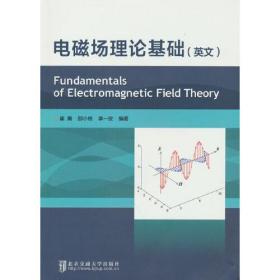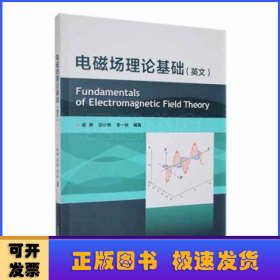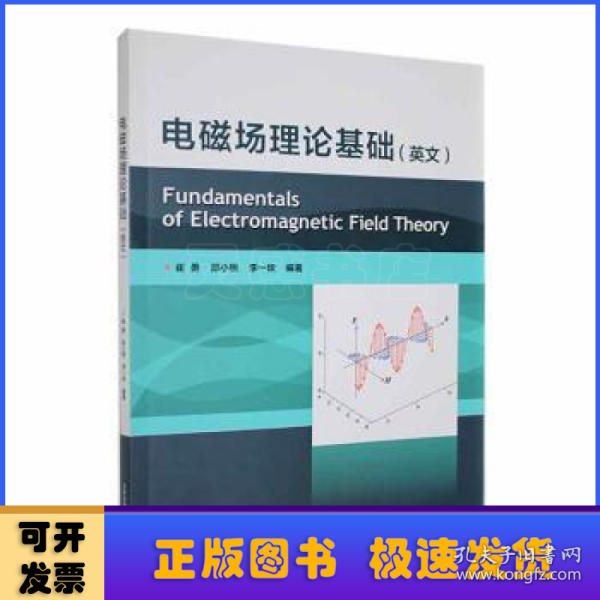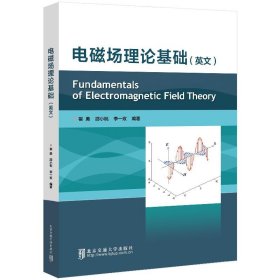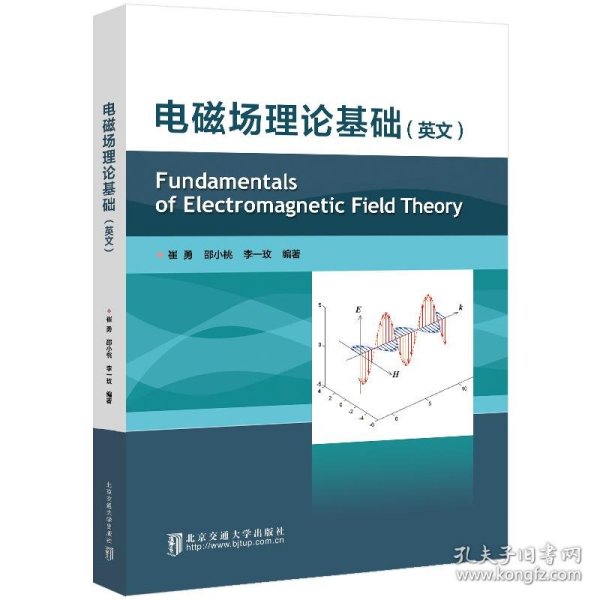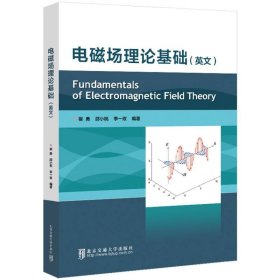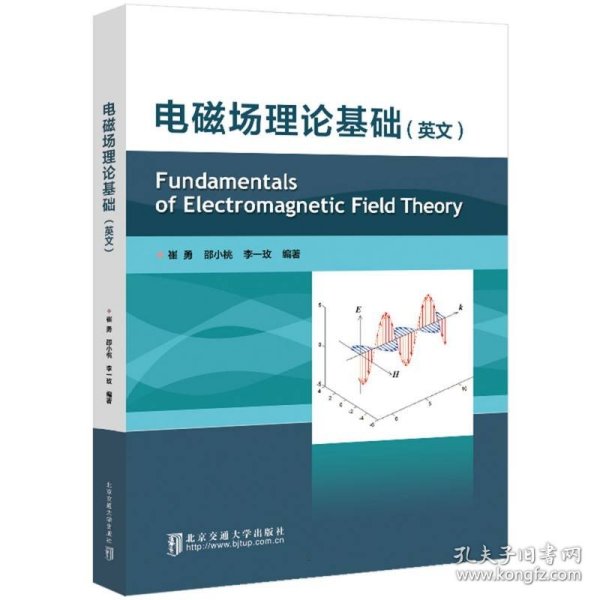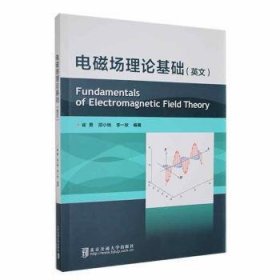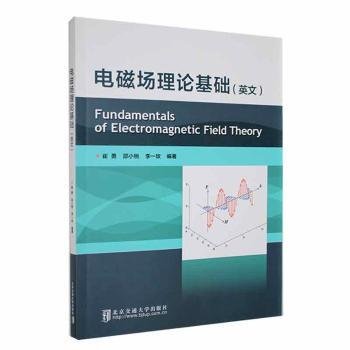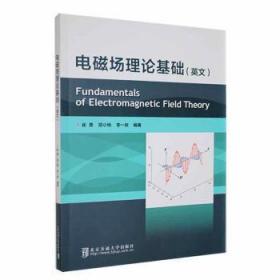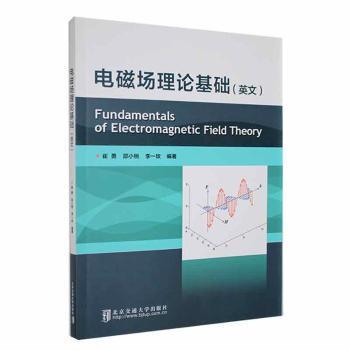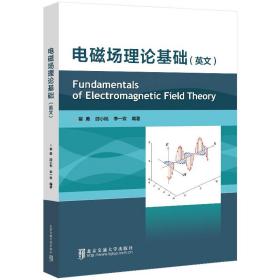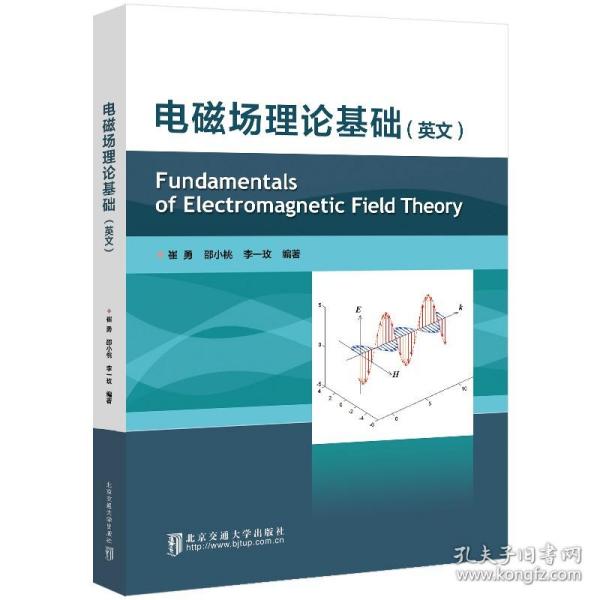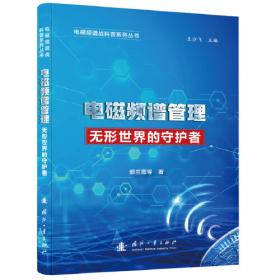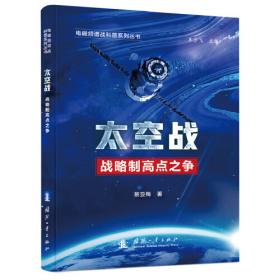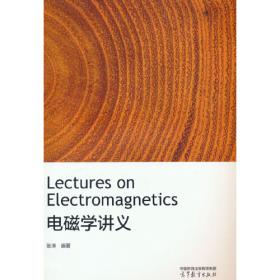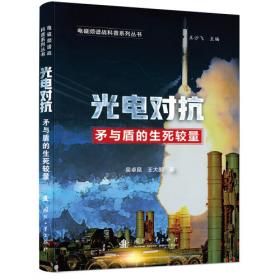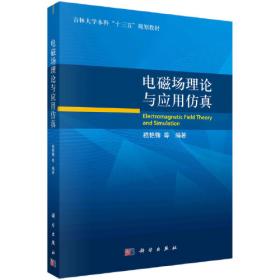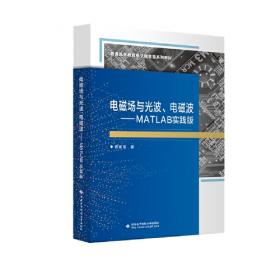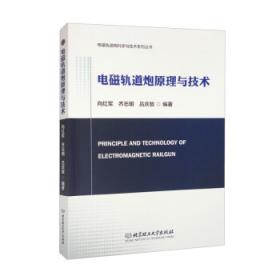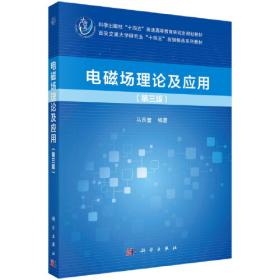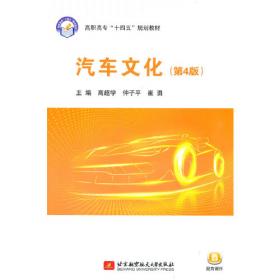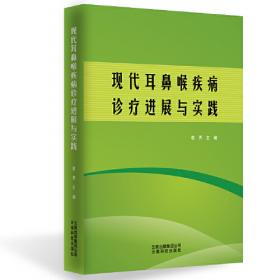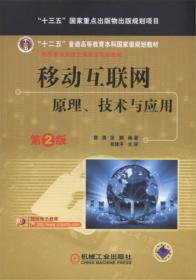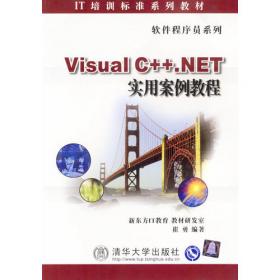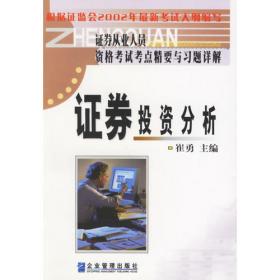电磁场理论基础=Fundamentals of Electromagnetic Field Theory
出版时间:
2023-03
版次:
1
ISBN:
9787512148895
定价:
59.00
装帧:
其他
开本:
16开
纸张:
胶版纸
字数:
396.000千字
2人买过
-
本书是北京交通大学电子信息工程学院电磁场与电磁波课程组多年教学成果的结晶,基于最新版中文教材内容编写而成。全书主要围绕电磁场的基本理论进行介绍,共6章,内容涵盖了矢量分析、静电场、恒定电场、恒定磁场、时变电磁场和平面波。每章的结构基本相同,首先是内容简介,然后是基本概念、基本理论介绍,关键公式的推导,以及与之对应的典型例题,接着是工程应用介绍,最后是本章内容的小结以及习题。全书列出了63道例题、155道习题,所有习题都附有答案。
本书适合作为通信、电子、自动化专业本科生“电磁场与电磁波”英文或双语教学教材,对于从事电磁场课程教学的教师也有参考价值。 Chapter 1 Vector analysis 1
1.1 Vector and vector operations 1
1.1.1 Scalar and vector 1
1.1.2 Vector operations 1
1.2 Scalar and vector fields 4
1.2.1 Classification of fields 4
1.2.2 Representation of field 5
1.3 Orthogonal coordinate systems and differential elements 6
1.3.1 Rectangular coordinate system 6
1.3.2 Cylindrical coordinate system 8
1.3.3 Spherical coordinate system 11
1.4 Directional derivative and the gradient of a scalar field 14
1.4.1 Directional derivative 14
1.4.2 The gradient of a scalar field 14
1.5 Flux and divergence of a vector field 18
1.5.1 Flux and flux source 18
1.5.2 Divergence of a vector field 20
1.5.3 Divergence theorem 23
1.6 Circulation and the curl of a vector field 24
1.6.1 Circulation and vortex source 24
1.6.2 The curl of a vector field 25
1.6.3 Stokes’ theorem 28
1.7 Helmholtz theorem 29
1.7.1 Non-divergence field and irrotational field 29
1.7.2 Helmholtz theorem 30
Summary 31
Exercise 33
Chapter 2 Electrostatic field 35
2.1 Coulomb’s law and electric field intensity 35
2.1.1 Coulomb’s law 36
2.1.2 Electric field intensity 36
2.2 Electrostatic field in vacuum 39
2.2.1 Flux and divergence 39
2.2.2 Circulation and curl 41
2.2.3 Basic equations of electrostatic field in vacuum 41
2.3 The electric potential 43
2.3.1 Definition of the electric potential 43
2.3.2 Calculation of the electric potential 44
2.3.3 Electric dipole 45
2.4 Electrostatic field in media 47
2.4.1 Polarization of a dielectric 48
2.4.2 Gauss’s law in a dielectric 49
2.5 Boundary conditions 51
2.5.1 Boundary conditions on the interface between two dielectrics 52
2.5.2 Boundary conditions on the interface between a dielectric and a conductor 53
2.6 Poisson’s equation and Laplace’s equation 55
2.7 Basic theorems of static fields 57
2.7.1 Green’s theorem 57
2.7.2 The uniqueness theorem 57
2.8 Method of images 59
2.8.1 Method of images for conducting planes 60
2.8.2 Method of images for a conducting sphere 62
2.8.3 Method of images for a conducting cylinder 63
2.9 Multi-conductor system and partial capacitance 66
2.9.1 The concept of capacitance 66
2.9.2 Partial capacitance in a multi-conductor system 67
2.10 Electrostatic field energy and electrostatic force 68
2.10.1 Electrostatic energy 69
2.10.2 Electrostatic force 70
2.11 Applications of electrostatic fields 72
Summary 74
Exercises 76
Chapter 3 Steady electric field 83
3.1 Current density 83
3.1.1 Current and current density 83
3.1.2 Current density and charge density 84
3.1.3 Ohm’s law 85
3.1.4 Joule’s law 85
3.2 Basic equations and the electromotive force 86
3.2.1 The equation of current continuity 86
3.2.2 Basic equations of a steady electric field 87
3.2.3 The electromotive force 89
3.3 Boundary conditions 90
3.4 Analogy between a steady electric field and an electrostatic field 92
3.5 Applications of steady electric fields 94
Summary 95
Exercise 96
Chapter 4 Steady magnetic field 99
4.1 Ampere’s force law and magnetic flux density 99
4.1.1 Ampere’s force law 99
4.1.2 The Biot-Savart law 100
4.1.3 Lorentz Force 101
4.2 Fundamental equations of steady magnetic field in vacuum 103
4.2.1 The equation of magnetic flux continuity 103
4.2.2 Ampere’s circuital law 104
4.3 Magnetic vector potential 108
4.3.1 Magnetic vector potential 108
4.3.2 Magnetic dipole 110
4.4 Fundamental equations of steady magnetic field in magnetic medium 111
4.4.1 Magnetization 111
4.4.2 Ampere’s circuital law for magnetic media 114
4.5 Boundary conditions for magnetic fields 116
4.5.1 Boundary conditions at the interface between two magnetic media 116
4.5.2 Boundary conditions for the surface of magnetic materials 118
4.5.3 Boundary conditions expressed by magnetic vector potentials 119
4.6 Magnetic scalar potential 120
4.6.1 Magnetic scalar potential and its equations 120
4.6.2 Multi valuedness of magnetic scalar potential 121
4.7 Inductance 122
4.7.1 Self-inductance and mutual inductance 122
4.7.2 Calculations of self - inductance and mutual inductance 123
4.8 Magnetic energy stored in a magnetic field and magnetic force 126
4.8.1 Magnetic energy stored in a magnetic field 126
4.8.2 Magnetic force 130
4.9 Applications of steady magnetic fields 132
Summary 133
Exercise 135
Chapter 5 Time-varying electromagnetic fields 140
5.1 Faraday’s law of electromagnetic induction 140
5.2 Displacement current 143
5.3 Maxwell’s equations 146
5.3.1 Maxwell’s equations 147
5.3.2 The constitutive equations 147
5.3.3 Maxwell’s equations in a source-free medium 148
5.3.4 Wave equation in a source-free medium 148
5.4 Boundary conditions for time-varying electromagnetic fields 149
5.4.1 Boundary conditions on the interface between two media 149
5.4.2 Boundary conditions for the surface of a perfect conductor 149
5.5 The phasor representation of sinusoidal electromagnetic fields 151
5.5.1 The phasor representation of a sinusoidal field 152
5.5.2 Maxwell’s equations in phasor form 154
5.5.3 Wave equations in phasor form 154
5.5.4 Complex permittivity, complex permeability 155
5.6 Poynting’s theorem and Poynting vector 157
5.6.1 The energy and power of a time-varying electromagnetic field 157
5.6.2 Poynting’s theorem in time domain 158
5.6.3 Poynting’s theorem in phasor form 162
5.7 The dynamic potential of time-varying electromagnetic fields 164
5.7.1 Wave equations in terms of dynamic potential functions 164
5.7.2 The solutions of D’Alembert’s equations 166
5.8 Applications of electromagnetic fields 169
Summary 170
Exercise 172
Chapter 6 Plane wave 176
6.1 Uniform plane wave in an ideal dielectric 176
6.1.1 Equations and solutions of a uniform plane wave 176
6.1.2 Propagation characteristics of a uniform plane wave 178
6.2 Polarization of an electromagnetic wave 183
6.2.1 Linear polarization 183
6.2.2 Circular polarization 184
6.2.3 Elliptical polarization 185
6.3 Uniform plane wave in a conducting medium 189
6.3.1 Wave equations and solutions 189
6.3.2 Propagation characteristics of a uniform plane wave 190
6.4 Normal incidence of a uniform plane wave 195
6.4.1 Conductor-conductor interface 195
6.4.2 Dielectric-perfect conductor interface 197
6.4.3 Dielectric-dielectric interface 199
6.4.4 Dielectric-conductor interface 203
6.5 Oblique incidence of a uniform plane wave 206
6.5.1 Dielectric-dielectric interface 206
6.5.2 Total reflection and total refraction 209
6.5.3 Dielectric-perfect conductor interface 215
6.6 Group velocity 218
6.7 Applications of electromagnetic waves 220
Summary 222
Exercises 225
Appendix A Answers to exercises 230
-
内容简介:
本书是北京交通大学电子信息工程学院电磁场与电磁波课程组多年教学成果的结晶,基于最新版中文教材内容编写而成。全书主要围绕电磁场的基本理论进行介绍,共6章,内容涵盖了矢量分析、静电场、恒定电场、恒定磁场、时变电磁场和平面波。每章的结构基本相同,首先是内容简介,然后是基本概念、基本理论介绍,关键公式的推导,以及与之对应的典型例题,接着是工程应用介绍,最后是本章内容的小结以及习题。全书列出了63道例题、155道习题,所有习题都附有答案。
本书适合作为通信、电子、自动化专业本科生“电磁场与电磁波”英文或双语教学教材,对于从事电磁场课程教学的教师也有参考价值。
-
目录:
Chapter 1 Vector analysis 1
1.1 Vector and vector operations 1
1.1.1 Scalar and vector 1
1.1.2 Vector operations 1
1.2 Scalar and vector fields 4
1.2.1 Classification of fields 4
1.2.2 Representation of field 5
1.3 Orthogonal coordinate systems and differential elements 6
1.3.1 Rectangular coordinate system 6
1.3.2 Cylindrical coordinate system 8
1.3.3 Spherical coordinate system 11
1.4 Directional derivative and the gradient of a scalar field 14
1.4.1 Directional derivative 14
1.4.2 The gradient of a scalar field 14
1.5 Flux and divergence of a vector field 18
1.5.1 Flux and flux source 18
1.5.2 Divergence of a vector field 20
1.5.3 Divergence theorem 23
1.6 Circulation and the curl of a vector field 24
1.6.1 Circulation and vortex source 24
1.6.2 The curl of a vector field 25
1.6.3 Stokes’ theorem 28
1.7 Helmholtz theorem 29
1.7.1 Non-divergence field and irrotational field 29
1.7.2 Helmholtz theorem 30
Summary 31
Exercise 33
Chapter 2 Electrostatic field 35
2.1 Coulomb’s law and electric field intensity 35
2.1.1 Coulomb’s law 36
2.1.2 Electric field intensity 36
2.2 Electrostatic field in vacuum 39
2.2.1 Flux and divergence 39
2.2.2 Circulation and curl 41
2.2.3 Basic equations of electrostatic field in vacuum 41
2.3 The electric potential 43
2.3.1 Definition of the electric potential 43
2.3.2 Calculation of the electric potential 44
2.3.3 Electric dipole 45
2.4 Electrostatic field in media 47
2.4.1 Polarization of a dielectric 48
2.4.2 Gauss’s law in a dielectric 49
2.5 Boundary conditions 51
2.5.1 Boundary conditions on the interface between two dielectrics 52
2.5.2 Boundary conditions on the interface between a dielectric and a conductor 53
2.6 Poisson’s equation and Laplace’s equation 55
2.7 Basic theorems of static fields 57
2.7.1 Green’s theorem 57
2.7.2 The uniqueness theorem 57
2.8 Method of images 59
2.8.1 Method of images for conducting planes 60
2.8.2 Method of images for a conducting sphere 62
2.8.3 Method of images for a conducting cylinder 63
2.9 Multi-conductor system and partial capacitance 66
2.9.1 The concept of capacitance 66
2.9.2 Partial capacitance in a multi-conductor system 67
2.10 Electrostatic field energy and electrostatic force 68
2.10.1 Electrostatic energy 69
2.10.2 Electrostatic force 70
2.11 Applications of electrostatic fields 72
Summary 74
Exercises 76
Chapter 3 Steady electric field 83
3.1 Current density 83
3.1.1 Current and current density 83
3.1.2 Current density and charge density 84
3.1.3 Ohm’s law 85
3.1.4 Joule’s law 85
3.2 Basic equations and the electromotive force 86
3.2.1 The equation of current continuity 86
3.2.2 Basic equations of a steady electric field 87
3.2.3 The electromotive force 89
3.3 Boundary conditions 90
3.4 Analogy between a steady electric field and an electrostatic field 92
3.5 Applications of steady electric fields 94
Summary 95
Exercise 96
Chapter 4 Steady magnetic field 99
4.1 Ampere’s force law and magnetic flux density 99
4.1.1 Ampere’s force law 99
4.1.2 The Biot-Savart law 100
4.1.3 Lorentz Force 101
4.2 Fundamental equations of steady magnetic field in vacuum 103
4.2.1 The equation of magnetic flux continuity 103
4.2.2 Ampere’s circuital law 104
4.3 Magnetic vector potential 108
4.3.1 Magnetic vector potential 108
4.3.2 Magnetic dipole 110
4.4 Fundamental equations of steady magnetic field in magnetic medium 111
4.4.1 Magnetization 111
4.4.2 Ampere’s circuital law for magnetic media 114
4.5 Boundary conditions for magnetic fields 116
4.5.1 Boundary conditions at the interface between two magnetic media 116
4.5.2 Boundary conditions for the surface of magnetic materials 118
4.5.3 Boundary conditions expressed by magnetic vector potentials 119
4.6 Magnetic scalar potential 120
4.6.1 Magnetic scalar potential and its equations 120
4.6.2 Multi valuedness of magnetic scalar potential 121
4.7 Inductance 122
4.7.1 Self-inductance and mutual inductance 122
4.7.2 Calculations of self - inductance and mutual inductance 123
4.8 Magnetic energy stored in a magnetic field and magnetic force 126
4.8.1 Magnetic energy stored in a magnetic field 126
4.8.2 Magnetic force 130
4.9 Applications of steady magnetic fields 132
Summary 133
Exercise 135
Chapter 5 Time-varying electromagnetic fields 140
5.1 Faraday’s law of electromagnetic induction 140
5.2 Displacement current 143
5.3 Maxwell’s equations 146
5.3.1 Maxwell’s equations 147
5.3.2 The constitutive equations 147
5.3.3 Maxwell’s equations in a source-free medium 148
5.3.4 Wave equation in a source-free medium 148
5.4 Boundary conditions for time-varying electromagnetic fields 149
5.4.1 Boundary conditions on the interface between two media 149
5.4.2 Boundary conditions for the surface of a perfect conductor 149
5.5 The phasor representation of sinusoidal electromagnetic fields 151
5.5.1 The phasor representation of a sinusoidal field 152
5.5.2 Maxwell’s equations in phasor form 154
5.5.3 Wave equations in phasor form 154
5.5.4 Complex permittivity, complex permeability 155
5.6 Poynting’s theorem and Poynting vector 157
5.6.1 The energy and power of a time-varying electromagnetic field 157
5.6.2 Poynting’s theorem in time domain 158
5.6.3 Poynting’s theorem in phasor form 162
5.7 The dynamic potential of time-varying electromagnetic fields 164
5.7.1 Wave equations in terms of dynamic potential functions 164
5.7.2 The solutions of D’Alembert’s equations 166
5.8 Applications of electromagnetic fields 169
Summary 170
Exercise 172
Chapter 6 Plane wave 176
6.1 Uniform plane wave in an ideal dielectric 176
6.1.1 Equations and solutions of a uniform plane wave 176
6.1.2 Propagation characteristics of a uniform plane wave 178
6.2 Polarization of an electromagnetic wave 183
6.2.1 Linear polarization 183
6.2.2 Circular polarization 184
6.2.3 Elliptical polarization 185
6.3 Uniform plane wave in a conducting medium 189
6.3.1 Wave equations and solutions 189
6.3.2 Propagation characteristics of a uniform plane wave 190
6.4 Normal incidence of a uniform plane wave 195
6.4.1 Conductor-conductor interface 195
6.4.2 Dielectric-perfect conductor interface 197
6.4.3 Dielectric-dielectric interface 199
6.4.4 Dielectric-conductor interface 203
6.5 Oblique incidence of a uniform plane wave 206
6.5.1 Dielectric-dielectric interface 206
6.5.2 Total reflection and total refraction 209
6.5.3 Dielectric-perfect conductor interface 215
6.6 Group velocity 218
6.7 Applications of electromagnetic waves 220
Summary 222
Exercises 225
Appendix A Answers to exercises 230
查看详情
-
全新
河北省保定市
平均发货29小时
成功完成率85.53%
-
全新
江苏省无锡市
平均发货17小时
成功完成率87.08%
-
全新
湖北省武汉市
平均发货23小时
成功完成率90.28%
-
全新
上海市黄浦区
平均发货11小时
成功完成率94.28%
-
全新
-
全新
山东省泰安市
平均发货8小时
成功完成率93.42%
-
全新
天津市津南区
平均发货13小时
成功完成率94.55%
-
全新
北京市丰台区
平均发货8小时
成功完成率90.78%
-
全新
江苏省南京市
平均发货11小时
成功完成率82.76%
-
全新
江苏省南京市
平均发货15小时
成功完成率82.91%
-
全新
浙江省嘉兴市
平均发货10小时
成功完成率94.12%
-
全新
河北省保定市
平均发货17小时
成功完成率82.85%
-
全新
河北省保定市
平均发货15小时
成功完成率81.66%
-
全新
浙江省杭州市
平均发货17小时
成功完成率93.42%
-
全新
江苏省宿迁市
平均发货24小时
成功完成率87.99%
-
电磁场理论基础:英文
重要提醒:::重要提醒::所有图书保证正版,按书名发货图片仅供参考, 有疑问请咨询客服,看清书名按书名发货
全新
北京市通州区
平均发货9小时
成功完成率89.58%
-
全新
北京市通州区
平均发货10小时
成功完成率86.69%
-
全新
北京市海淀区
平均发货11小时
成功完成率93.25%
-
全新
广东省广州市
平均发货19小时
成功完成率86.6%
-
电磁场理论基础(英文)
图片是系统识别图,仅供参考,以书号或书名为准 如有套装书(或图片与书名不符),价格异常,可能是单本书的价
全新
河北省保定市
平均发货11小时
成功完成率87.87%
-
全新
河北省保定市
平均发货14小时
成功完成率81.88%
-
全新
北京市东城区
平均发货11小时
成功完成率95.88%
-
全新
河北省保定市
平均发货11小时
成功完成率90.5%
-
全新
广东省广州市
平均发货9小时
成功完成率86.82%
-
全新
江西省九江市
平均发货11小时
成功完成率80.17%
-
九品
-
全新
江苏省南京市
平均发货23小时
成功完成率38.46%
-
全新
北京市房山区
平均发货8小时
成功完成率78.57%
-
全新
河北省保定市
平均发货14小时
成功完成率68.85%
-
全新
江西省吉安市
平均发货63小时
成功完成率89.15%
-
全新
湖北省武汉市
平均发货19小时
成功完成率92.73%
-
全新
河北省廊坊市
平均发货70小时
成功完成率80.77%
-
全新
广东省广州市
平均发货54小时
成功完成率11.76%
-
全新
四川省成都市
平均发货58小时
成功完成率82.98%
-
全新
山东省泰安市
平均发货24小时
成功完成率92.48%
-
全新
河北省保定市
平均发货38小时
成功完成率85.77%
-
全新
山东省泰安市
平均发货22小时
成功完成率86.02%
-
全新
河北省廊坊市
平均发货19小时
成功完成率76.76%
-
全新
河北省廊坊市
平均发货17小时
成功完成率81.37%
-
全新
江苏省南京市
平均发货41小时
成功完成率73.53%
-
全新
河北省保定市
平均发货8小时
成功完成率83.55%

 占位居中
占位居中


